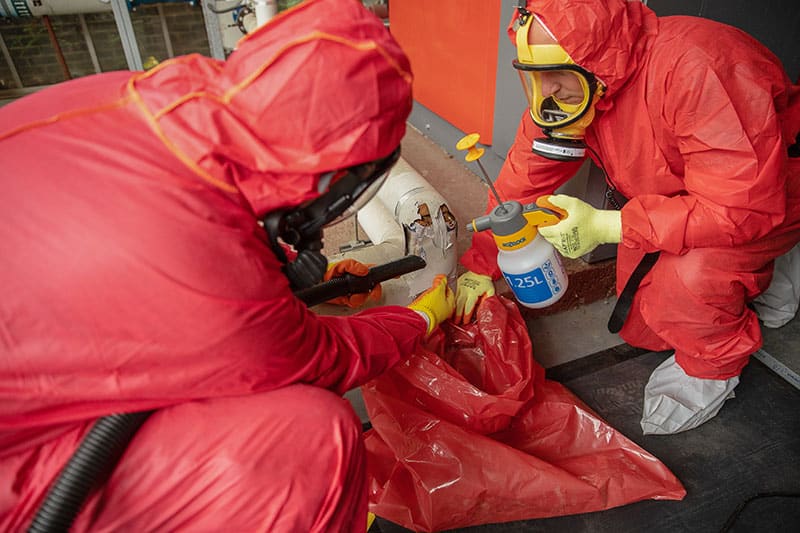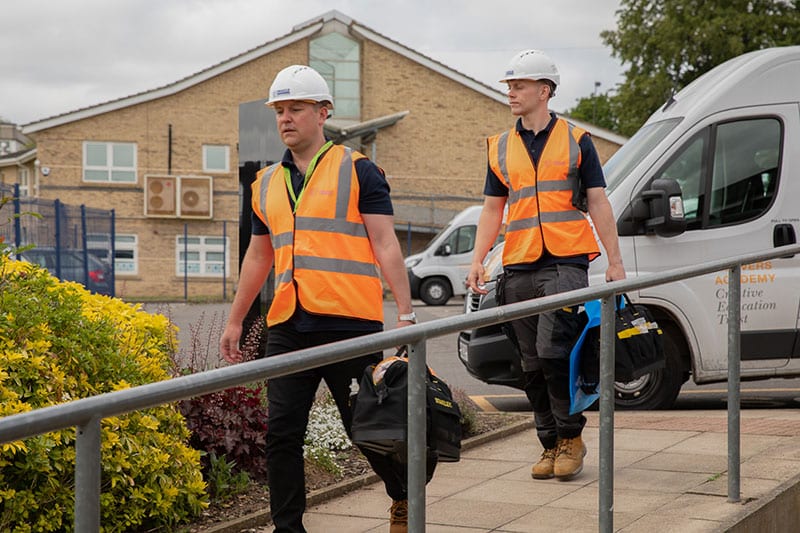What are the permits and legal requirements for asbestos removal?
Asbestos was used widely in the construction industry until its serious health effects became well-known, thus causing it to been banned in the UK in 1999. However, because it was so prominent in building materials before its ban, many homes and commercial structures still contain asbestos today.
In an undisturbed and undamaged state, asbestos-containing materials (ACMs) don’t pose an immediate health risk. However, when ACMs break down or become damaged, they can release microscopic asbestos fibres that hang in the air and are easy to inhale. Those fibres attach themselves to the lungs permanently, often leading to life-threatening cancers and health problems several years down the road.
Legal requirements and permits help control the risk of asbestos exposure to keep residents, workers, and visitors safe.

What are the legal frameworks for asbestos management?
The Control of Asbestos Regulations 2012 contains the UK’s asbestos laws for both non-licensed and licensed work. It covers best practices and requirements like the following:
- The person who is responsible for managing asbestos on a property.
- When ACMs can be left in place instead of being removed from a building.
- Health surveillance requirements for people performing non-licensed asbestos work.
The Health and Safety Executive (HSE), along with local authorities and the Office of Rail and Road, enforce asbestos regulations in the UK.
What is a duty holder?
The term “duty holder” refers to non-domestic properties. The duty holder is the person who is responsible for managing asbestos on the premises. The duty goes to the person responsible for protecting others on the premises in all ways. For example, that may be the manager of a business or the owner of a building.
Asbestos removal work categories
There are three basic work categories for the removal of asbestos: non-licensed work, non-licensed work that the HSE must be notified about, and licensed work.
Whether or not asbestos work requires a licence is determined by risk. Higher-risk work should only be done by a licensed specialist, while less-risky work can sometimes be handled by a person without a licence.
Before beginning any asbestos project, the duty holder must carry out a risk assessment. This step identifies and controls the asbestos risk on the premises, and it helps determine what type of work the project requires.
Non-licensed work
Non-licensed asbestos work may be allowed if the following requirements are met:
- The work will not take up a lot of time; it’s considered short-duration work.
- The air does not have a concentration of asbestos over 0.6 fibres per cubic centimetre of air (f/cm3) within 10 minutes.
- The work will not create a concentration of more than 0.1f/cm3 within 4 hours.
- Only non-friable ACMs are involved in the work.
- The ACMs are in good condition and won’t be disturbed during the project.
Notifiable non-licensed work
Certain types of non-licensed work must meet extra requirements. This is considered notifiable non-licensed work (NNLW).
The requirements for NNLW are as follows:
- An enforcing authority must be notified of the work.
- The areas where the work will take place must be identified.
- Medical examinations must take place.
- Health records and work registers must be maintained.
Whether or not asbestos removal work is notifiable depends on the type of work, the type of ACM being worked with, and the condition of the ACM. For example, the following types of asbestos work may be NNWL:
- Building maintenance includes a certain amount of asbestos removal.
- The ACMs being worked with are friable, meaning they’re easier to damage than non-friable materials.
- The ACMs to be removed are in poor condition.
Licensed asbestos removal work
High-risk asbestos removal work has to be done by a licensed contractor. For example:
- Asbestos exposure can be of high intensity.
- There’s the potential that the control limit for the concentration of asbestos fibres in the air will be exceeded.
- The work includes friable asbestos, such as insulation.
- The work has a high possibility of damaging ACMs.
- There’s a lot of asbestos dust to clean up.
Licensable training for supervisors
Licensable training from UKATA, includes supervisory training in its programs. This type of training is for those who will supervise employees who may be exposed to asbestos.
There are a few types of supervisory training options. For example, new supervisors should take a 3-day or 18-hour course, while the refresher training for supervisors only has to be 1 day or 6 hours. Also, supervisors who already have asbestos qualifications may be exempt from parts of the training.
Who can remove asbestos in the UK?
While some types of asbestos work can be handled by non-licensed workers, it’s always best to work with a professional asbestos contractor.
At the very least, a person with asbestos experience should conduct the risk assessment and advise you on how to move forward. From there, you can find out if the asbestos project has a high or low risk of exposure.
If there’s a low risk of asbestos exposure, you may be able to handle the job yourself or with your team. However, if there’s a high risk, it’s both legally and professionally in your favour to hire experts. That’s the best way to ensure everyone stays safe.
What to look for in a licensed contractor
There are several factors to consider when searching for an asbestos contractor:
- Accreditation and certifications
- Expertise and industry reputation
- Compliance with legal and safety standards
- Insurance coverage
We have an article about how to choose the right asbestos management company that will help with this decision.
Penalties for non-compliance
If you don’t comply with the Control of Asbestos Regulations 2012 that are specific to your type of asbestos work, you could face serious legal consequences.
Penalties include hefty fines and even imprisonment. According to the HSE, fines can be up to £20,000 and imprisonment can be as long as one year.
There are examples of fines exceeding £20,000, too. For example, when a construction firm exposed the public to asbestos fibres during a renovation project, they were fined £90,000. Read the press release here.
The HSE also clarifies that punishments may exceed the norm. The fine can be “unlimited” based on the seriousness of the exposure event, and imprisonment can be as long as 24 months.
Note that an asbestos survey is required even if the building is derelict or vacant.
Asbestos reporting and record-keeping
Properly managing asbestos includes the following steps:
- Determining who the duty holder is
- Inspecting the building
- Creating an asbestos register
- Writing an asbestos management plan
- Communicating the situation to other workers
- Maintaining records
Within that, certain types of asbestos work must be reported to the HSE, as we covered above in the notifiable and non-notifiable work sections.
Record-keeping guidelines
Assessing the asbestos situation in your building isn’t a one-time job. Managing asbestos is an ongoing task, and records must be updated regularly.
Here are the HSE’s guidelines regarding record-keeping:
- Whenever work involves ACMs, the register must be updated.
- ACMs must be checked a minimum of one time per year to see if they’re damaged or disturbed.
- The asbestos management plan must be updated and dated whenever there’s a change made to it.
Additionally, anyone working on the premises should know to check the asbestos register if their work could disturb ACMs.
Final thoughts
Even though asbestos is no longer used in construction or renovation projects, it still exists in buildings that pre-date 2000. While undamaged asbestos doesn’t pose a risk, asbestos that is or could be damaged may release dangerous fibres into the air that put anyone on the premises at risk.
The Control of Asbestos Regulations 2012 and the HSE have all of the information a duty holder needs to properly manage ACMs on their property. It’s necessary to know if the work you’re planning requires a licensed contractor or not. This allows you to stay safe while adhering to the law. If you don’t comply with the UK’s asbestos regulations, you could face serious penalties.
Every step of asbestos management, from identifying ACMs to keeping records up to date, is necessary for safe, responsible asbestos management.
Contact us today for a free asbestos work quote.

Written by Callum McDonald
Callum McDonald is an expert in asbestos quality management, ensuring rigorous adherence to regulations and high-quality standards in removal projects. His focus on enhancing quality and client satisfaction makes him a crucial asset in safety and compliance within the field. Callum's expertise in technical support and oversight of licensed works underscores his commitment to excellence in asbestos management, providing invaluable guidance to clients in this specialised area.

